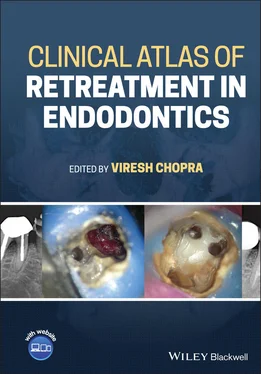It is important to evaluate the endodontic failures so a decision can be made among non‐surgical retreatment, surgical retreatment or extraction [33, 34, 35].
Retreatment is classified into two major groups [18].
Non‐surgical or conventional retreatment: the retreatment procedure is done through the root canals. Used in cases where the initial treatment is incomplete or presence of inadequate treatments diagnosed as failures.
Surgical retreatment: the treatment procedure is carried out after surgical exposure of the apical portion of the tooth.
Clinicians should always opt for non‐surgical retreatment over the surgical option unless a successful outcome cannot be achieved by a non‐surgical approach.
With the advent of magnification and newer retreatment technologies, non‐surgical retreatment procedures take care of mechanical failures, previously missed canals or radicular subcrestal fractures. Non‐surgical endodontic retreatment procedures have enormous potential for success if the guidelines for case selection are respected and the most relevant technologies, best materials and precise techniques are utilized [21–23].
This book focuses on a variety of failed endodontic cases that have been treated successfully with different non‐surgical as well as surgical approaches. The aim of this book is to discuss:
different possible reasons for failure of endodontic treatment
different ways to avoid iatrogenic errors while performing a root canal treatment
different approaches taken to successfully retreat endodontically failed cases
do's and don'ts during an endodontic treatment
do's and don'ts during an endodontic retreatment
the decision‐making process between surgical and non‐surgical retreatment options.
1 1 Schilder H. Cleaning and shaping the root canal. Dent Clin North Am 1974; 18: 269–96
2 2 Schilder H. Filling root canals in three dimensions. Dent Clin North Am 1967;723–44.
3 3 Torabinejad M, Anderson P, Bader J, et al. Outcomes of root canal treatment and restoration, implant‐supported single crowns, fixed partial dentures, and extraction without replacement: a systematic review. J Prosthet Dent 2007; 98:285–311.
4 4 de Chevigny C, Dao TT, Basrani BR, et al. Treatment outcome in endodontics: the Toronto study – phase 4: initial treatment. J Endod 2008; 34:258–63.
5 5 Sjogren U, Hagglund B, Sundqvist G, Wing K. Factors affecting the long‐term results of endodontic treatment. J Endod 1990; 16:498–504.
6 6 Salehrabi R, Rotstein I. Endodontic treatment outcomes in a large patient population in the USA: an epidemiological study. J Endod 2004; 30:846–50.
7 7 Ng YL, Mann V, Rahbaran S, Lewsey J, Gulabivala K. Outcome of primary root canal treatment: systematic review of the literature – part 2: influence of clinical factors. Int Endod J 2007; 41:6–31.
8 8 Nair PN. On the causes of persistent apical periodontitis: a review. Int Endod J 2006; 39:249–81.
9 9 Davis SR, Brayton SM, Goldman M. The morphology of the prepared root canal: a study utilizing injectable silicone. Oral Surg Oral Med Oral Pathol 1972; 34:642–8.
10 10 Peters OA, Barbakow F, Peters CI. An analysis of endodontic treatment with three nickel‐titanium rotary root canal preparation techniques. Int Endod J 2004; 37: 849–59.
11 11 Stropko JJ. Canal morphology of maxillary molars: clinical observations of canal configurations.J Endod 1999; 25:446–50.
12 12 Tronstad L, Barnett F, Cervone F. Periapical bacterial plaque in teeth refractory to endodontic treatment. Endod Dent Traumatol 1990; 6:73–7.
13 13 Koppang HS, Koppang R, Solheim T, Aarnes H, Stolen SO. Cellulose fibers from endodontic paper points as an etiological factor in postendodontic periapical granulomas and cysts. J Endod 1989; 15:369–72.
14 14 Nair PN, Sjogren U, Krey G, Sundqvist G. Therapy‐resistant foreign body giant cell granuloma at the periapex of a root‐filled human tooth. J Endod 1990; 16:589–95.
15 15 Nair PN. Cholesterol as an aetiological agent in endodontic failures: a review. Aust Endod J 1999; 25:19–26.
16 16 Simon JH. Incidence of periapical cysts in relation to the root canal. J Endod 1980; 6: 845–8.
17 17 Nair PN, Pajarola G, Schroeder HE. Types and incidence of human periapical lesions obtained with extracted teeth. Oral Surg Oral Med Oral Pathol Oral Radiol Endod 1996; 81:93–102.
18 18 Zuolo M, Kherlakian D, De Mello Jr J, Carvalho M. Fagundes M. (2014). Reintervention in Endodontics Quintessence Publishing, Batavia, IL.
19 19 Torabinejad M, Bahjri K. Essential elements of evidenced‐based endodontics: steps involved in conducting clinical research. J Endod 2005; 31:563–9.
20 20 American Association of Endodontists. Glossary of contemporary terminology for endodontics. 2020 www.aae.org/specialty/clinical‐resources/glossary‐endodontic‐terms/
21 21 European Society of Endodontology. Quality guidelines for endodontic treatment: consensus report of the European Society of Endodontology. Int Endodontic J, 39:921–30, 2006.
22 22 Carr GB. Retreatment. In: Cohen S, Burns R (eds) Pathways of the Pulp, 7th edn, St Louis, Mosby Inc., 1998.
23 23 Scianamblo MJ. Endodontic failures: the retreatment of previously endodontically treated teeth, Revue D'Odonto. Stomatologie 17:5, pp. 409–23, 1988.
24 24 Hess W, Zürcher E. The Anatomy of the Root Canals of the Teeth of the Permanent and Deciduous Dentitions, William Wood & Co, New York, 1925.
25 25 Ruddle CJ. Endodontic failures: the rationale and application of surgical retreatment, Revue D'Odonto. Stomatologie 17:6, pp. 511–69, 1988.
26 26 Goon WWY. Managing the obstructed root canal space: rationale and techniques, J Calif Dent Assoc 19:5, pp. 51–60, 1991.
27 27 Glick DH, Frank AL. Removal of silver points and fractured posts by ultrasonics. J Prosth Dent 1986; 55:212–15.
28 28 Bertrand MF, Pellegrino JC, Rocca JP, Klinghofer A, Bolla M. Removal of Thermafil root canal filling material. J Endod 23:1, pp. 54–57, 1997.
29 29 West JD. The relation between the three‐dimensional endodontic seal and endodontic failure. Masters thesis, Boston University, 1975
30 30 Torabinejad M, Ung B, Kettering JD. In vitro bacterial penetration of coronally unsealed endodontically treated teeth. J Endod 16:12, pp. 566–69, 1990.
31 31 Alves J, Walton R, Drake D. Coronal leakage: endotoxin penetration from mixed bacterial communities through obturated, post‐prepared root canals. J Endod 24:9, pp. 587–91, 1998.
32 32 Southard DW. Immediate core buildup of endodontically treated teeth: the rest of the seal, Pract Periodont Aesthet Dent 11:4, pp. 519–26, 1999.
33 33 Stabholz A, Friedman S. Endodontic retreatment‐ case selection and technique. Part 2: treatment planning for retreatment. J Endod 14:12, pp. 607–14, 1988.
34 34 Allen RK, Newton CW, Brown CE. A statistical analysis of surgical and non‐surgical endodontic retreatment cases. J Endod 15:6, pp. 261–66, 1989.
35 35 Kvist T, Reit C. Results of endodontic retreatment: a randomized clinical study comparing surgical and nonsurgical procedures. J Endod 25:12, pp. 814–17, 1999.
1 Clinical Case 1 – Perforation repair: A case of repair of pulpal floor perforation caused by excessive cutting of the floor of the pulp chamber
Mohammad Hammo
Introduction to the case: pulpal floor perforation caused by excessive cutting of the floor of the pulp chamber.
Age: 30 years old.
Gender: female.
Medical history: non‐contributory.
Identification: mandibular left first molar (Tooth 36).
Читать дальше












